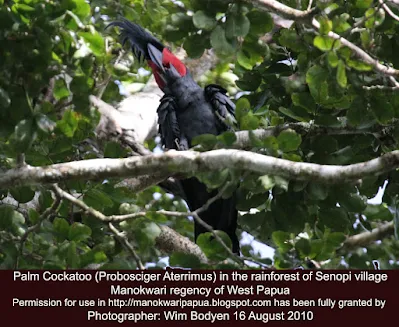 |
| Palm Cockatoo |
Deforestation of rainforest
On 19 August 2010, we returned to Manokwari. We passed by a place where huge areas of rainforest had been cleared to make way for for palm oil plantation. The company that runs logging businesses and sawit palm plantation is PT. Medco Papua Hijau Selaras (meaning Medco Papua Green Harmony Corporation). Around 6000 hectares of high biodiversity of the tropical rainforest are being replaced by a monoculture sawit plantation. Please, read my article entitled The Leasing of Papuan Tropical Rainforest Too Low for Compensation Too Stupid of Conversion.
The first phase of seedling planting was conducted in January 2010. I took some pictures of the palm seedlings with a sad look. The magnificent thousands of years old tropical forest has been replaced by the palm oil plantation that will only be productive for 35 years. I wonder if the beautiful palm cockatoo birds will like to eat the fruits of these sawit trees. I don't think they will. Why? Because the sawit plant (Elaeis guineensis) is not an endemic species of New Guinea island. The previous sawit plantation run by PT Perkebunan II Medan in Prafi was a big failure. Everybody in the area knows about it. Yet the officials in the Plantation Agency and Department of Forestry of Manokwari regency just do not care about it.
It is not only Manokwari regency that is facing deforestation, most of the rainforests throughout Papua or New Guinea island experience the same problem. We need to stop this. My ecotourism campaign is one of the alternative solutions that I offer to Papuan people. Papuan should know that their forest is a precious treasure that they need to preserve for future Papuan generation. NO FOREST NO FUTURE. by Charles Roring
Also read:
- Watching Birds of Paradise;
- Birding Center in Aiwatar Hill of Senopi Village

